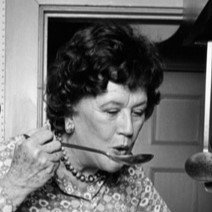I have read several food-related books and memoirs that I have enjoyed, each for very different reasons. But none of them resonated with me personally as much as My Life in France by Julia Child (and co-author Alex Prud’Homme). I knew very little about Child before reading her memoir, only that she was some kind of famous chef on television. Since I enjoy eating but have had very little interest in learning how to cook for most of my life, I never had any particular reason or opportunity to discover more about her. Something drew me to her memoir, however, and then I also had the opportunity to visit Julia Child: A Recipe for Life, an exhibit at the Henry Ford Museum in Detroit, Michigan. Between the book and the exhibit, what emerged was a picture of complex woman who was interested in learning new things throughout her life and whose passion for cooking I could understand much more readily once I compared it to my own artistic passions and pursuits.
First of all, I had no idea that the famous chef didn’t actually start to cook and find her calling in the kitchen until her mid-thirties. Her specific claim to fame is that she made French cuisine accessible to the American public with her debut cookbook Mastering the Art of French Cooking and her television programs, most notably The French Chef, which premiered in 1963. Born in 1912, Child grew up in a well-off family that had a cook and she did not spend any time in the kitchen learning how to prepare even simple dishes. She had quite a life even before starting to experiment in the kitchen, an interest that she developed when she and her husband Paul moved to France after World War II. Once she dedicated herself to French cooking, however, she remained committed to learning and teaching more complicated culinary techniques in her forties and fifties.
The life that she had before becoming a chef was fascinating in its own right. In 1942, Child joined the Office of Strategic Services (OSS), which was the intelligence agency of the U.S. during WWII and the precursor to the Central Intelligence Agency (CIA). She began as a typist at OSS headquarters in Washington DC, but her college education soon landed her a position as a top-secret researcher working directly for the head of OSS. While some of the tasks she performed as a research assistant seem they were probably fairly tedious, she was also given some more interesting assignments. Most notably, when working at the OSS Emergency Sea Rescue Equipment Section (ESRES), she assisted the developers of a shark repellent needed to ensure that curious sharks would not explode underwater explosives targeting German U-boats. Child began to experiment with cooking various concoctions as a shark repellent, which were sprinkled in the water near the explosives and repelled sharks. Still in use today, the experimental shark repellent is now considered the chef’s first foray into the world of cooking.
Still working for the OSS, Child was posted to Ceylong (now Sri Lanka) in 1944, where she met her husband Paul Child. He was also an OSS employee at the time and is credited to first introducing his wife to fine cuisine. Child was later posted to both Kunming and Chunking, China. She received the Emblem of Meritorious Civilian Service in recognition of her work abroad during the war.
Once the couple was married in 1946, they lived for a time in Washington DC, until Paul joined the United States Foreign Service and he was given a post in Paris. In France, Child fell in love with French food. When she first moved to Paris, the markets provided her with a sense of community as she shopped and conversed with vendors, learning from them about fresh produce. And throughout her life, she repeatedly stated that her first meal at La Couronne in Rouen was a culinary revelation. To the New York Times, she described that meal as “an opening up of the soul and spirit for me.”
My Life in France didn’t inspire me to pursue French cooking (although I admit I bought a few cookbooks and dabbled a bit, mastering more than a few delicious crock pot recipes). Rather, the memoir encouraged me to continue practicing my own artistic pursuits with a similar passion for research and good technique. I was inspired by her descriptions of how she went about researching culinary techniques and trying many iterations of each recipe in order to get a scientific understanding of how ingredients were combining and chemical processes were influencing the end result.
More than just identifying with Child as a fellow artist, I identify with many aspects of her personal experiences and relationships, as described in My Life in France. For one thing, I identify very closely with all the times that the Childs were uprooted. In the twenty years (and counting) of our relationship, my husband and I have lived in Ann Arbor, Michigan; Washington, DC; the New York City metro area; Southwest Michigan; Des Moines, Iowa; and Austin, Texas. In each location, we have had to build new lives, both professionally and personally. So Child’s descriptions of her own efforts and struggles in pursuing new directions and finding new friends resonated with me. Moreover, I identify with Julia’s relationship with her husband Paul, who was also an intellectual and artist. Some of my favorite parts of her memoir were passages that described the collaboration between the two on photos and illustrations for her cookbooks, and how Paul was her “behind the scenes sous-chef” when she first started giving cooking demonstrations to promote her cookbook and again when she started filming her television show. Fundamentally, I identify with many aspects of her personality – her longing to be intelligent and respected for her intelligence, her willingness to try new things and build new skills, her curiosity regarding how and why different techniques work, and her perfectionism (that actually I believe qualifies as obsession).
As the icing on the cake, I really enjoyed the many unexpected events and details in My Life in France, which is often what makes a memoir a full five stars for me. Tucked into the pages of Child’s memoir, many of which are focused on cooking and enjoying delicious culinary concoctions, are the stories of unexpected challenges and delights from throughout her life. There is an account of how McCarthyism impacted U.S. Government Foreign Service Members, as well as a description of the practice of Stag Hunting in France. Apparently at the time, the French still conducted Stag Hunting “in the classical manner established in medieval times [including] the costumes, protocols, jargon, dogs, special trumpet calls, and elaborate manners [that] remained just as they had in the time of the kings named Louis.” These kinds of recollections bring the memoir fully to life, adding spice to the narrative just like a fresh herb might be added to a recipe as a finishing ingredient.



This website was created with a lot of love, Coke Zero, and tacos by Kumquat Creative.